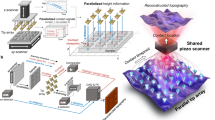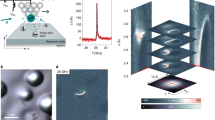Abstract
Scanning probe microscopy is a versatile and powerful method that uses sharp tips to image, measure and manipulate matter at surfaces with atomic resolution1,2. At cryogenic temperatures, scanning probe microscopy can even provide electron tunnelling spectra that serve as fingerprints of the vibrational properties of adsorbed molecules3,4,5 and of the electronic properties of magnetic impurity atoms6,7, thereby allowing chemical identification. But in many instances, and particularly for insulating systems, determining the exact chemical composition of surfaces or nanostructures remains a considerable challenge. In principle, dynamic force microscopy should make it possible to overcome this problem: it can image insulator, semiconductor and metal surfaces with true atomic resolution8,9,10, by detecting and precisely measuring11,12,13 the short-range forces that arise with the onset of chemical bonding between the tip and surface atoms14,15 and that depend sensitively on the chemical identity of the atoms involved. Here we report precise measurements of such short-range chemical forces, and show that their dependence on the force microscope tip used can be overcome through a normalization procedure. This allows us to use the chemical force measurements as the basis for atomic recognition, even at room temperature. We illustrate the performance of this approach by imaging the surface of a particularly challenging alloy system and successfully identifying the three constituent atomic species silicon, tin and lead, even though these exhibit very similar chemical properties and identical surface position preferences that render any discrimination attempt based on topographic measurements impossible.
This is a preview of subscription content, access via your institution
Access options
Subscribe to this journal
Receive 51 print issues and online access
$199.00 per year
only $3.90 per issue
Buy this article
- Purchase on Springer Link
- Instant access to full article PDF
Prices may be subject to local taxes which are calculated during checkout



Similar content being viewed by others
References
Eigler, D. M. & Schweizer, E. K. Positioning single atoms with a scanning tunnelling microscope. Nature 344, 524–526 (1990)
Sugimoto, Y. et al. Atom inlays performed at room temperature using atomic force microscopy. Nature Mater. 4, 156–159 (2005)
Stipe, B. C., Rezaei, M. A. & Ho, W. Single-molecule vibrational spectroscopy and microscopy. Science 280, 1732–1735 (1998)
Heinrich, A. J., Lutz, C. P., Gupta, J. A. & Eigler, D. M. Molecule cascades. Science 298, 1381–1387 (2002)
Pascual, J. I., Lorente, N., Song, Z., Conrad, H. & Rust, H.-P. Selectivity in vibrationally mediated single-molecule chemistry. Nature 423, 525–528 (2003)
Madhavan, V., Chen, W., Jamneala, T., Crommie, M. F. & Wingreen, N. S. Tunneling into a single magnetic atom: spectroscopic evidence of the Kondo resonance. Science 280, 567–569 (1998)
Li, J., Schneider, W.-D., Berndt, R. & Delley, B. Kondo scattering observed at a single magnetic impurity. Phys. Rev. Lett. 80, 2893–2896 (1998)
Morita, S., Wiesendanger, R. & Meyer, E. Noncontact Atomic Force Microscopy. NanoScience and Technology (Springer, Berlin, 2002)
García, R. & Pérez, R. Dynamic atomic force microscopy methods. Surf. Sci. Rep. 47, 197–301 (2002)
Giessibl, F. J. Advances in atomic force microscopy. Rev. Mod. Phys. 75, 949–983 (2003)
Lantz, M. A. et al. Quantitative measurement of short-range chemical bonding forces. Science 291, 2580–2583 (2001)
Abe, M., Sugimoto, Y., Custance, O. & Morita, S. Room-temperature reproducible spatial force spectroscopy using atom-tracking technique. Appl. Phys. Lett. 87, 173503 (2005)
Hoffmann, R., Kantorovich, L. N., Baratoff, A., Hug, H. J. & Güntherodt, H.-J. Sublattice identification in scanning force microscopy on alkali halide surfaces. Phys. Rev. Lett. 92, 146103 (2004)
Pérez, R., Payne, M., Štich, I. & Terakura, K. Role of covalent tip-surface interactions in noncontact atomic force microscopy. Phys. Rev. Lett. 78, 678–681 (1997)
Livshits, A. I., Shluger, A. L., Rohl, A. L. & Foster, A. S. Model of noncontact scanning force microscopy on ionic surfaces. Phys. Rev. B 59, 2436–2448 (1999)
Abe, M., Sugimoto, Y., Custance, O. & Morita, S. Atom tracking for reproducible force spectroscopy at room temperature with non-contact atomic force microscopy. Nanotechnology 16, 3029–3034 (2005)
Oyabu, N. et al. Single atomic contact adhesion and dissipation in dynamic force microscopy. Phys. Rev. Lett. 96, 106101 (2006)
Ke, S. H., Uda, T., Pérez, R., Štich, I. & Terakura, K. First-principles investigation of tip-surface interaction on a GaAs(110) surface: implications for atomic force and scanning tunneling microscopies. Phys. Rev. B 60, 11631–11638 (1999)
Hembacher, S., Giessibl, F. J. & Mannhart, J. Force microscopy with light-atom probes. Science 305, 380–383 (2004)
Sugimoto, Y. et al. Real topography, atomic relaxations, and short-range chemical interactions in atomic force microscopy: The case of the α-Sn/Si(111)-(√3 × √3)R30° surface. Phys. Rev. B 73, 205329 (2006)
Sugimoto, Y. et al. Non-contact atomic force microscopy study of the Sn/Si(1 1 1) mosaic phase. Appl. Surf. Sci. 241, 23–27 (2005)
Charrier, A. et al. Contrasted electronic properties of Sn-adatom-based (√3 × √3)R30° reconstructions on Si(111). Phys. Rev. B 64, 115407 (2001)
Albrecht, T. R., Grütter, P., Horne, D. & Rugar, D. Frequency modulation detection using high-Q cantilevers for enhanced force microscope sensitivity. J. Appl. Phys. 69, 668–673 (1991)
Giessibl, F. J. Forces and frequency shifts in atomic resolution dynamic-force microscopy. Phys. Rev. B 56, 16010–16015 (1997)
Sader, J. E. & Jarvis, S. P. Accurate formulas for interaction force and energy in frequency modulation force spectroscopy. Appl. Phys. Lett. 84, 1801–1803 (2004)
Jelinek, P., Wang, H., Lewis, J. P., Sankey, O. F. & Ortega, J. Multicenter approach to the exchange-correlation interactions in ab initio tight-binding methods. Phys. Rev. B 71, 235101 (2005)
Acknowledgements
We thank F. J. Giessibl and M. Reichling for their comments on the manuscript, and T. Namikawa and K. Mizuta for technical assistance. This work was supported by the Handai FRC, the JST, the 21st Century COE programme, and the MEXT of Japan. The work of P.P. and R.P. is supported by the MCyT, the Juan de la Cierva Programme, the CCC-UAM (Spain), and the FORCETOOL project (EU). The work of P.J. is supported by the MSMT and GAAV.
Author information
Authors and Affiliations
Corresponding author
Ethics declarations
Competing interests
Reprints and permissions information is available at www.nature.com/reprints. The authors declare no competing financial interests.
Supplementary information
Supplementary Information
This file contains Supplementary Notes, supplementary Figures S1-S2 with Legends, Supplementary Tables I-IV and additional references. This file contains: the determination of the relative interaction ratio for a single-atomic layer of In grown on a Si(111) substrate, the acquisition parameters for all the sets of force curves and images presented, and a discussion regarding the fundamentals behind the almost complete independence of the relative interaction ratio from the tip-apex chemical termination. (PDF 527 kb)
Rights and permissions
About this article
Cite this article
Sugimoto, Y., Pou, P., Abe, M. et al. Chemical identification of individual surface atoms by atomic force microscopy. Nature 446, 64–67 (2007). https://doi.org/10.1038/nature05530
Received:
Accepted:
Issue Date:
DOI: https://doi.org/10.1038/nature05530
This article is cited by
-
Composite Nanoarchitectonics Towards Method for Everything in Materials Science
Journal of Inorganic and Organometallic Polymers and Materials (2024)
-
Observation of electron orbital signatures of single atoms within metal-phthalocyanines using atomic force microscopy
Nature Communications (2023)
-
Pore-engineered nanoarchitectonics for cancer therapy
NPG Asia Materials (2023)
-
Ultra Low Energy Nuclear Synthesis via Three-Body Resonances in Cuboctahedron CsH\(_2\)Pd\(_{12}\) Cluster
Few-Body Systems (2023)
-
Zero to zero nanoarchitectonics with fullerene: from molecules to nanoparticles
Journal of Nanoparticle Research (2023)
Comments
By submitting a comment you agree to abide by our Terms and Community Guidelines. If you find something abusive or that does not comply with our terms or guidelines please flag it as inappropriate.



